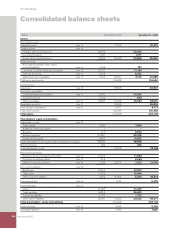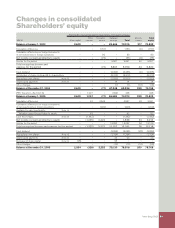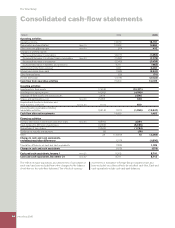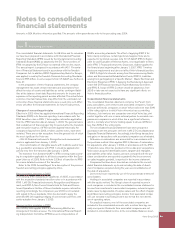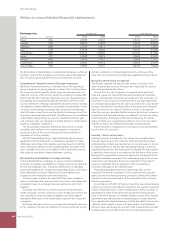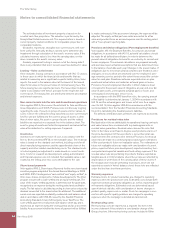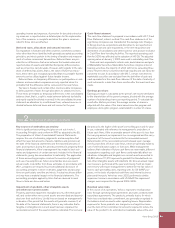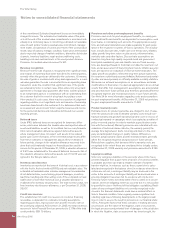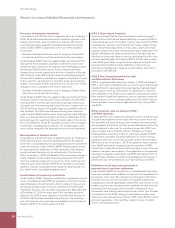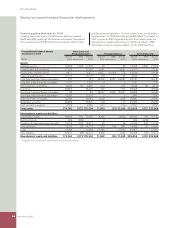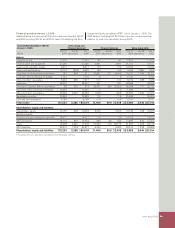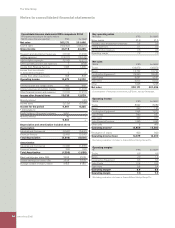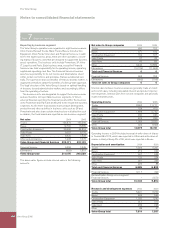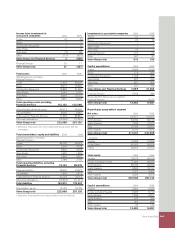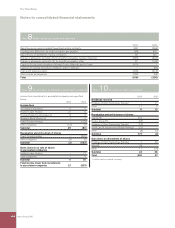Volvo 2005 Annual Report Download - page 96
Download and view the complete annual report
Please find page 96 of the 2005 Volvo annual report below. You can navigate through the pages in the report by either clicking on the pages listed below, or by using the keyword search tool below to find specific information within the annual report.
The Volvo Group
92 Volvo Group 2005
Notes to consolidated fi nancial statements
Fair value of derivative instruments
In accordance with IAS 39, which is applied by Volvo as of January 1,
2005, all derivative fi nancial instruments should be reported in the
balance sheet at fair value. The difference between IAS 39 and
accounting principles applied for derivative fi nancial instruments
under Swedish GAAP is dependent on the use of the derivative
instruments:
– Derivative fi nancial instruments used for hedging of forecasted
commercial cash-fl ows and forecasted electricity consumption:
Under Swedish GAAP Volvo has applied hedge accounting for the
main part of these derivatives and these instruments have conse-
quently not been reported in the balance sheet (“Off-balance sheet
instruments”). Gains and losses on these contracts have been
charged to the income statement at the time of maturity of the spe-
cifi c contracts. Under IFRS, the fair value of outstanding derivative
instruments is debited or credited to a separate component of equity
to the extent the requirements for cash-fl ow hedge accounting are
fulfi lled. To the extent that the requirements are not met, the unreal-
ized gain or loss is charged to the income statement.
– Derivative fi nancial instruments used for hedging of interest-rate
risks and currency-rate risks on loans:
Under Swedish GAAP Volvo has applied hedge accounting for these
derivatives and the carrying value of such derivatives has therefore
corresponded to currency-rate and interest-rate gains and losses
accruable up to the reporting date. Under the more complex rules in
IAS 39 Volvo has chosen not to apply hedge accounting for interest
rate contracts. The difference between carrying values reported
under Swedish GAAP and fair values to be reported under IFRS per-
tains to unrealized interest rate gains and losses attributable to the
period between the reporting date and maturity dates of the deriva-
tives. The difference should be charged to income over the hedged
instrument’s remaining time to maturity. The unrealized gains and
losses will be charged to the fi nancial net in the income statement.
Derecognition of fi nancial assets
In accordance with IAS 39, which ís applied by Volvo as of January 1,
2005, fi nancial assets should be derecognized from the balance
sheet when substantially all risks and rewards have been transferred
to an external party. Under Swedish GAAP, fi nancial assets should
be derecognized at settlement or if the ownership of the fi nancial
assets has been transferred to an external party. The transition
effect on January 1, 2005, attributable to this accounting change is
mainly related to certain dealer fi nancing arrangements for which
Volvo has retained components of credit risk. Such credit risk com-
mitments have under Swedish GAAP been reported as contingent
liabilities. This has mainly affected the segment reporting and to a
less extent Volvo’s consolidated balance sheet.
Consolidation of temporary investments
Under Swedish GAAP, temporary investments in subsidiaries should
not be consolidated. Under IFRS, all subsidiaries should be consoli-
dated. Restatements and transition effects relating to this account-
ing change pertains mainly to Volvo’s investment in the LB Smith
distribution business. This operation was acquired in May 2003 and
at December 31, 2004 the major part of this operation had been
divested. The 2004 income statement is restated with the parts of
LB Smith that have been divested during the year. The remaining
part, still owned by Volvo, has been consolidated in full according to
Swedish GAAP in the fourth quarter of 2004.
IFRS 2 Share-based Payments
Volvo has decided that the “new share-based incentive program”
adopted at the 2004 Annual General Meeting is covered by IFRS 2
Share-based payments. The impact, however, was limited. The IFRS
2 distinguishes between “cash-settled” and “equity-settled” compo-
nents of share-based payments, in Volvo cases, shares. The Volvo
program include both a cash-settled and an equity-settled part. The
equity-settled part was earlier accounted for at fair value and pro-
vided for as an accrued expense over the vesting period with a “true
up” each reporting date. According to IFRS 2 the fair value is deter-
mined at the grant-date, recognized as an expense during the vest-
ing period and credited to equity. Additional social costs are
reported as a liability and is revalued at each balance sheet day in
accordance with URA 46.
IFRS 5 Non-Current Asset Held for Sale
and Discontinued Operations
IFRS 5 is applied prospectively from January 1, 2005, according to
IFRS 1. Volvo had not identifi ed any non-current assets that could be
classifi ed held for sales and which would have had material impact
on the balance sheet as of December 31, 2004 and no effect has
been identifi ed in the 2004 income statement. Discontinued opera-
tions pertain to signifi cant operations, such as operating segments,
comprising one or more cash-generating units. The rules for discon-
tinued operations have not been applicable for Volvo during 2004
and 2005.
Other transition rules according to IFRS 1
and IFRS standards
In applying IFRS, Volvo had the possibility to chose to measure prop-
erty, plant and equipment at fair value. Volvo has chosen not to use
this possibility but continue the present valuation of property, plant
and equipment at historical cost less accumulated depreciation. The
same treatment is also used for investment properties. IFRS 1 pro-
vides an option how to treat the effects of Changes in Foreign
Exchange Rates, according to IAS 21. A fi rst time adopter of IFRS
could set the cumulative translation difference to zero for foreign
operations. Volvo has chosen this possibility and set the translation
difference to zero at January 1, 2004. Assumptions made under pre-
vious GAAP shall not be changed under the transition to IFRS
unless there is objective evidence that those were in error. Volvo has
made no changes in assumptions in the preparation of comparative
information prepared in accordance with IFRS. According to SIC 12,
Special Purpose Entities should be consolidated as from January 1,
2004. Volvo has not identifi ed any such Special Purpose Entities.
Defi nition of cash and cash equivalents in
presentation of cash-fl ow statements
Under Swedish GAAP, all investments in marketable debt securities
have been included in the defi nition of cash and cash equivalents for
the purpose of the cash-fl ow statement. In accordance with Volvo’s
fi nancial risk policy, all such securities should fulfi ll requirements
regarding low risk and high liquidity. Under IFRS, investments in mar-
ketable securities are excluded from the defi nition of cash and cash
equivalents for the purpose of the cash-fl ow statement if these
instruments have maturity dates beyond three months from the date
of investment. In the 2004 closing no marketable securities were
defi ned as cash equivalents according to IFRS. Classifi cation of cash
and cash equivalents in the cash-fl ow statement does not affect
Volvo’s net fi nancial position.


